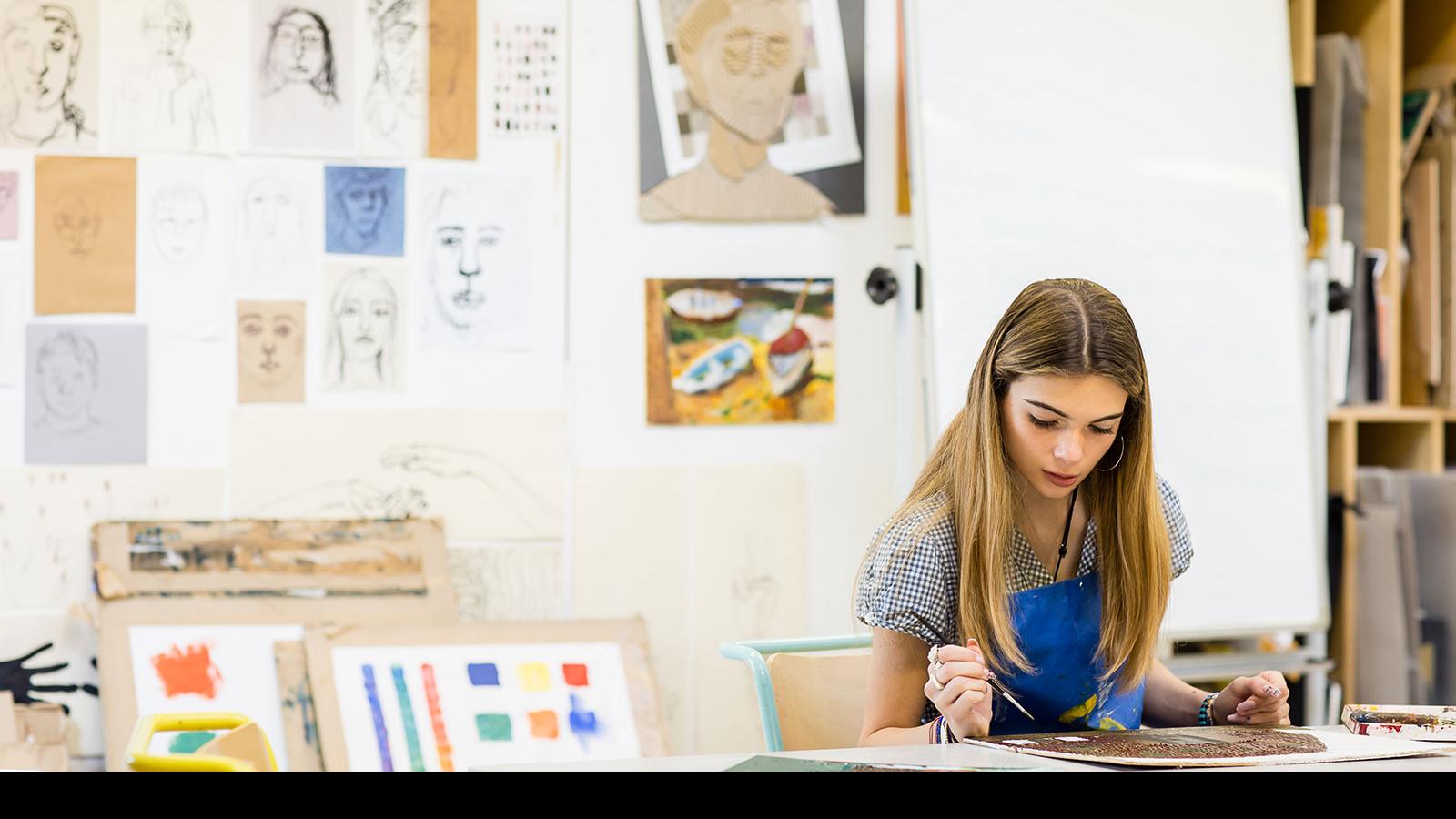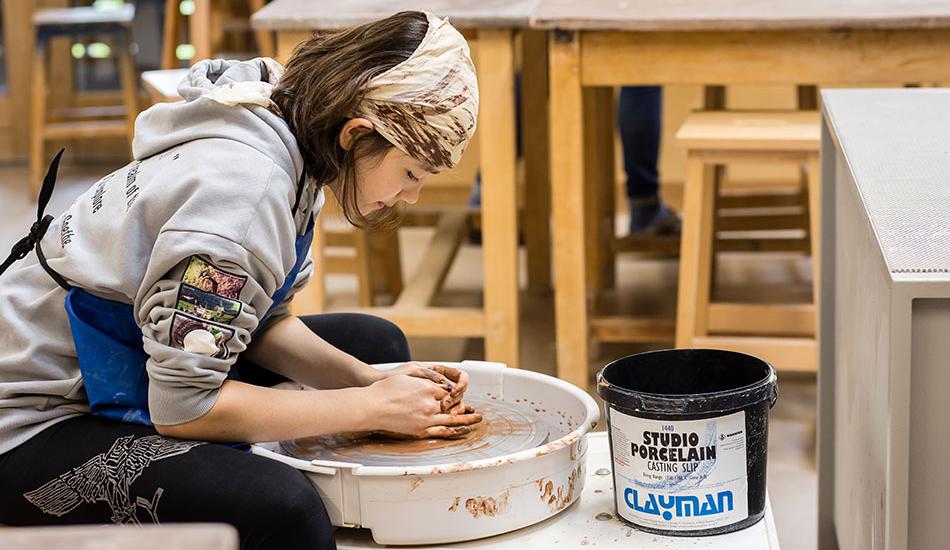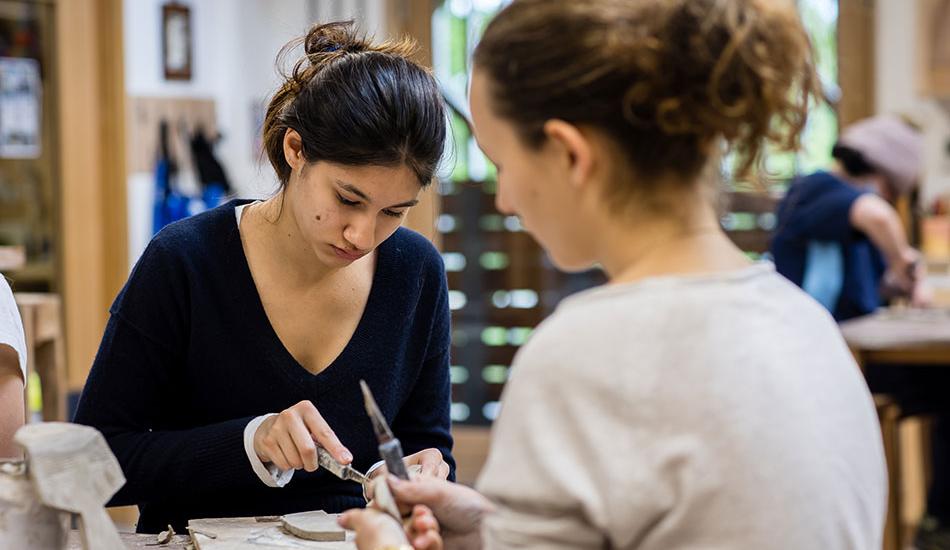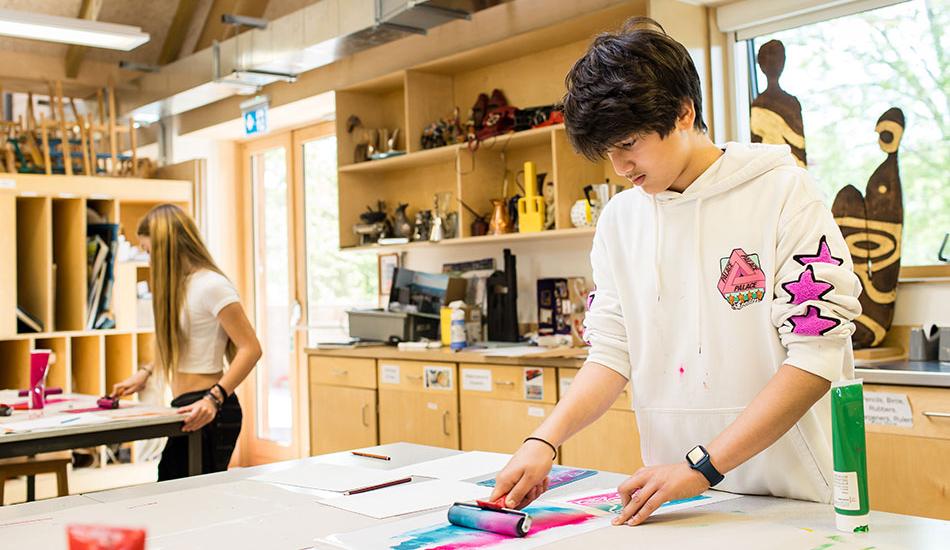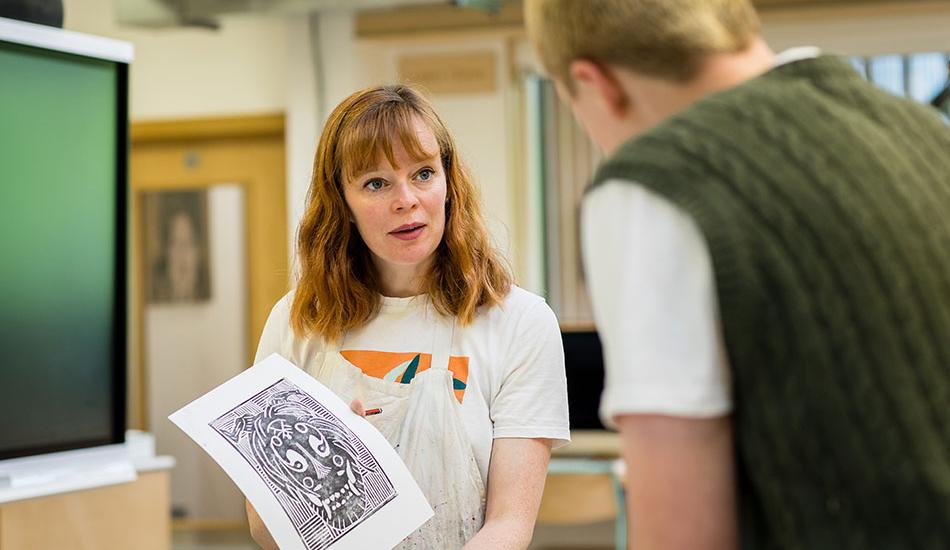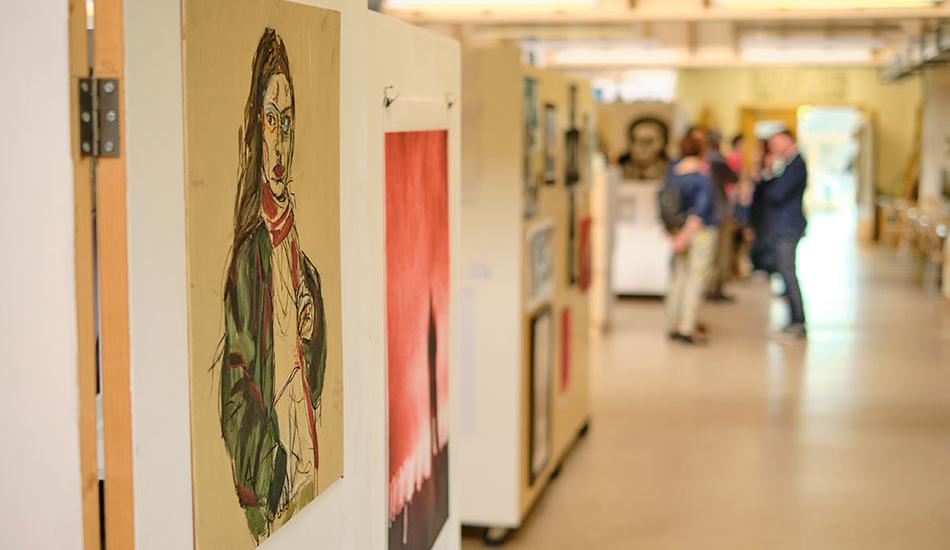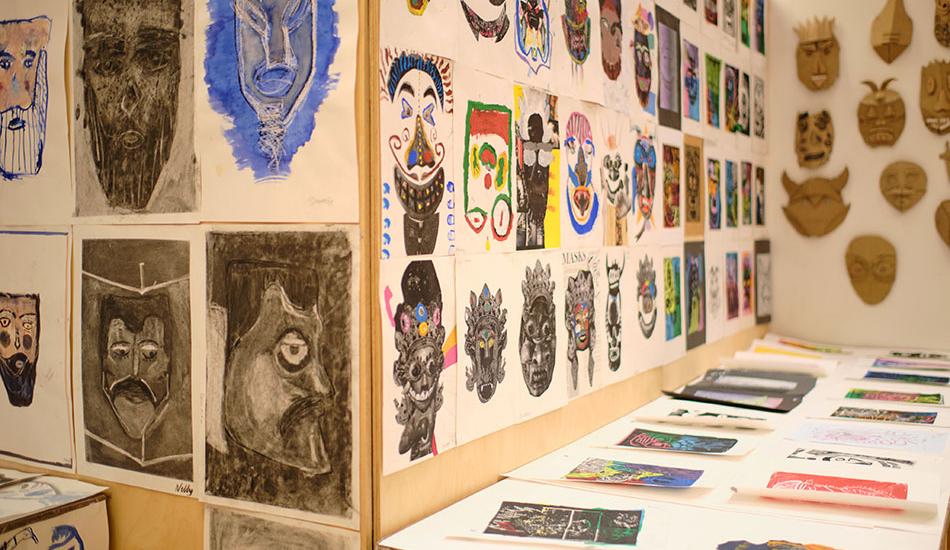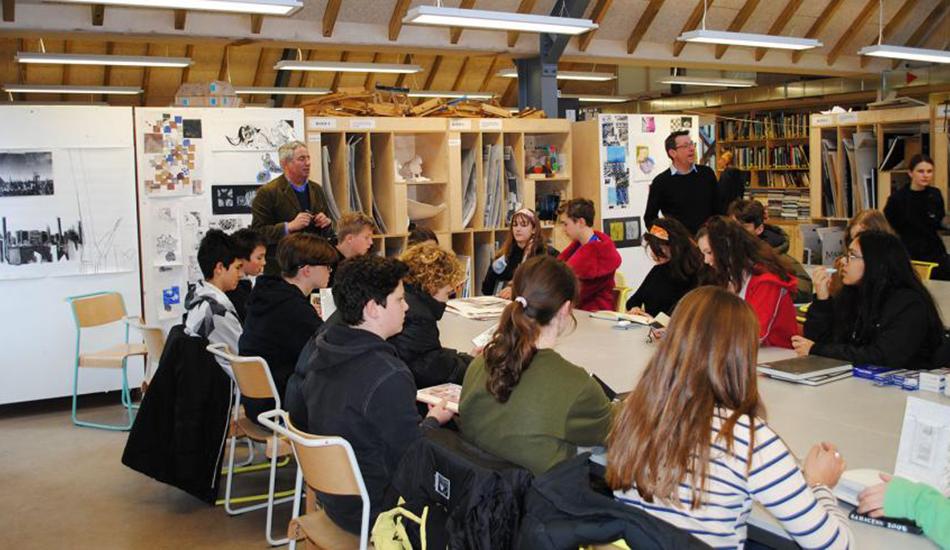The ethos of the teaching of Art at Bedales is to deliver a wide range of exciting and varied projects, giving the students the possibility of working with a variety of media, processes and techniques in a supportive and encouraging environment, taught by specialists and practitioners within an award-winning, purpose-built Art & Design Building.
- Block 3 (Year 9)
- Block 4 and 5 (Years 10 and 11)
- Sixth Form
The underlying aim of Art in Block 3 (Year 9) is to provide an accessible and enjoyable experience for all abilities with an emphasis towards teaching individual creativity. The course develops the student’s observational and perceptual skills, creative thinking and confidence with materials and process. The year also stands as a stepping stone for the Art Bedales Assessed Course (BAC), introducing them to the possibilities and potential of the subject.
The students will undertake a rotational program exploring painting, drawing, painting ceramics, sculpture and printmaking in eight-week projects. This will allow them to experience what the department has to offer, taught by teachers in their specialism. These projects are loosely based around portrait, landscape and still life. All the projects have a discipline in observational and experimental drawing and will develop the student’s perceptual and creative skills underpinned by the exploration into the formal elements. Greater sophistication and confidence with materials and processes is encouraged across all disciplines.
Painting approaches are developed by students responding to the world around them and increasing their confidence with colour mixing and paint application. A broad range of inventive printmaking techniques are explored from dry point, lino printing, collagraphy and screen printing. In Ceramics, students experiment with a range of coiling, pinching slabbing, inlay and sgraffito. In sculpture, the principles of modelling in 3D are explored with assemblage and the building of structures.
In addition to this course there is the availability of a generous provision of activity and after school sessions that can complement the provision for Art, at this level, if more ambitious projects are wished to be followed by pupils.
Head of Department
Michael Bruzon, Head of Art
The unique and innovative BAC Art course, developed by Bedales in response to what was considered the limitations of the GCSE, gives students the opportunity to explore and gain further experience of considering the formal elements of art, while developing their confidence through the introduction to more sophisticated processes and materials to develop a more personal responses to subjects and themes. Students have the opportunity to explore a variety of practices using both traditional skills, as well as digital, and conceptual approaches. The course includes the following elements: Drawing and Painting, Sculpture and Ceramics, Printmaking and Photography, Illustration and Graphic techniques.
The first year is structured to be predominantly teacher led, encouraging good practice in the subject and covering a range of media available in separate projects. There is an emphasis on good standards of drawing, particularly from observation but also using secondary source material such as personal photographs and digital manipulation. The course aims are realised within group focussed projects across 2D and 3D, with themes and approaches that allow individual outcomes.
The course is introduced through a stand-alone drawing workshop that explores ways of responding to a variety of primary and secondary source material through a different media exploring a variety of perceptual and practical approaches. Sketchbook development and presentation is addressed to encourage good practice throughout the course. This is underpinned by contextualisation through annotation and reflection and artist research, and is brought together into a sketchbook that illustrates development from initial ideas to a final outcome.
In the second year, students produce two projects using a list of starting points that allow them to develop their own themes and work with personal subject matter, built around the formal elements.
These four projects are submitted at the end of the course and the student’s portfolio is assessed by the department and moderated by an experienced OCR examiner and former winner of the BP Portrait Award.
Head of Department
Michael Bruzon, Head of Art
A Level Art offers something of value to a wide range of pupils and not only those who might choose a future career in the creative arts. This innovative course integrates practical work and Art History / Contextual Studies. This course is designed to be a mix of traditional, digital media and contemporary conceptual practices. Taught with Art School Foundation and direct entry degree courses in mind, the course prepares students for later specialisation in such areas as Fine Art, Graphic Design, Printmaking, Photography, Ceramics, Illustration, Architecture, Fashion Design, Stage, Theatre Design, Film and Media.
The Bedales Art Department follows the OCR A Level Art and Design curriculum that allows for development of a personal project, a written related study and an externally set theme researched then created under exam conditions. The personal investigation and related study is 60% of the possible A Level mark, with the externally set task making up the other 40%. The course is structured over 21 months and is followed because of the high regard amongst top academic universities and the structure is highly compatible to build a portfolio that can be used to successfully apply to art school or universities.
During the first term the students are introduced to the department through a series of 2D and 3D projects led by a specialist member of staff and based around a single theme. This allows the student to consider process and problem solving through making and doing. They will then be asked to reflect and refine the work to develop a series of outcomes at the beginning of the second term.
Students will undertake an internal exam starting in the middle of the Spring Term. Here they have the opportunity to develop and research around an externally set theme (usually the current year's A Level paper), working towards a final outcome that will be completed in exam conditions. This gives students experience of what is expected in the final exam.
This work and the previous year’s study gives the students some starting points to begin a personal project that will be developed over the summer and the two remaining terms. Themes and genres can include:
- Portraiture
- Landscape
- Still life
- Human form
- Abstraction and paint manipulation
- Experimental film and imagery
- Narrative and installation
There is an emphasis on drawing but students engage in various techniques. These can include: mark-making in both wet and dry media, collage and mixed-media, casting, ceramic construction, glazing, a range of silk screen and intaglio processes, photographic processes and digital manipulation.
At the end of the first year, in addition to working practically, students will need to research and develop a related study on a chosen theme that can have - but not exclusively - a connection with their practical work. The aim of the related study is to enable students to develop their ability to communicate their knowledge and understanding of art historical movements, genres, practitioners and artworks.
Examining board: OCR
Head of Department
Michael Bruzon, Head of Art

